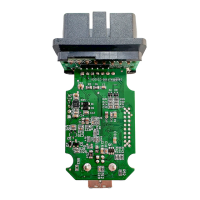RM0090 Rev 18 1151/1749
RM0090 Ethernet (ETH): media access control (MAC) with DMA controller
1239
Multicast destination address filter
The MAC can be programmed to pass all multicast frames by setting the PAM bit in the
Frame filter register. If the PAM bit is reset, the MAC performs the filtering for multicast
addresses based on the HM bit in the Frame filter register. In Perfect filtering mode, the
multicast address is compared with the programmed MAC destination address registers
(1–3). Group address filtering is also supported. In Hash filtering mode, the MAC performs
imperfect filtering using a 64-bit Hash table. For hash filtering, the MAC uses the 6 upper
CRC (see note 1 below) bits of the received multicast address to index the content of the
Hash table. A value of 000000 selects bit 0 in the selected register and a value of 111111
selects bit 63 in the Hash Table register. If the corresponding bit is set to 1, then the
multicast frame is said to have passed the Hash filter; otherwise, the frame has failed the
Hash filter.
Note: This CRC is a 32-bit value coded by the following polynomial (for more details refer to
Section 33.5.3):
Hash or perfect address filter
The DA filter can be configured to pass a frame when its DA matches either the Hash filter
or the Perfect filter by setting the HPF bit in the Frame filter register and setting the
corresponding HU or HM bits. This configuration applies to both unicast and multicast
frames. If the HPF bit is reset, only one of the filters (Hash or Perfect) is applied to the
received frame.
Broadcast address filter
The MAC does not filter any broadcast frames in the default mode. However, if the MAC is
programmed to reject all broadcast frames by setting the BFD bit in the Frame filter register,
any broadcast frames are dropped.
Unicast source address filter
The MAC can also perform perfect filtering based on the source address field of the
received frames. By default, the MAC compares the SA field with the values programmed in
the SA registers. The MAC address registers [1:3] can be configured to contain SA instead
of DA for comparison, by setting bit 30 in the corresponding register. Group filtering with SA
is also supported. The frames that fail the SA filter are dropped by the MAC if the SAF bit in
the Frame filter register is set. Otherwise, the result of the SA filter is given as a status bit in
the Receive Status word (see RDES0: Receive descriptor Word0).
When the SAF bit is set, the result of the SA and DA filters is AND’ed to decide whether the
frame needs to be forwarded. This means that either of the filter fail result will drop the
frame. Both filters have to pass the frame for the frame to be forwarded to the application.
Inverse filtering operation
For both destination and source address filtering, there is an option to invert the filter-match
result at the final output. These are controlled by the DAIF and SAIF bits in the Frame filter
register, respectively. The DAIF bit is applicable for both Unicast and Multicast DA frames.
The result of the unicast/multicast destination address filter is inverted in this mode.
Similarly, when the SAIF bit is set, the result of the unicast SA filter is inverted. Table 191
Gx() x
32
x
26
x
23
x
22
x
16
x
12
x
11
x
10
x
8
x
7
x
5
x
4
x
2
x1++++++++++++++=

